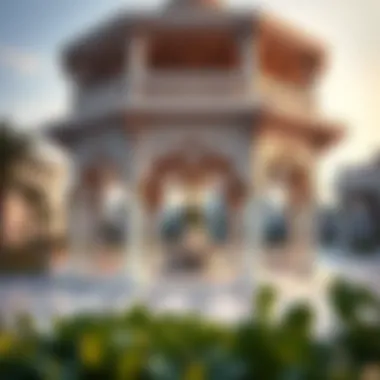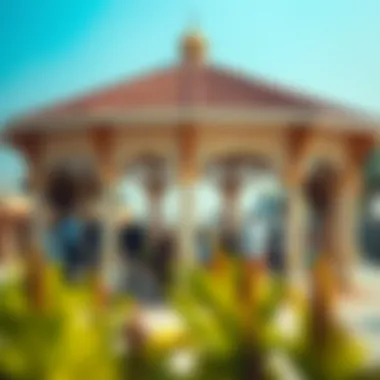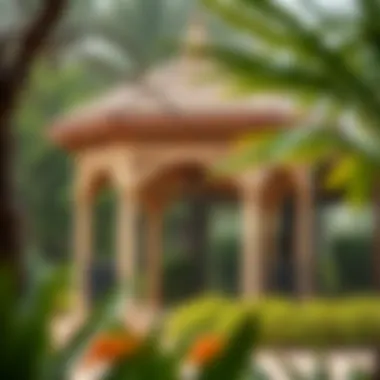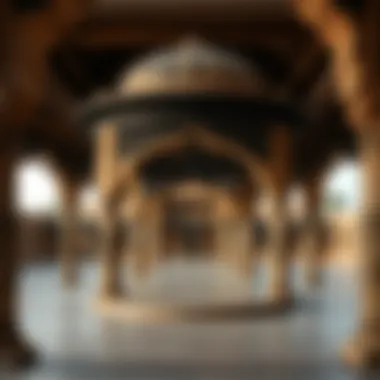Cultural and Architectural Insights of Souqat's Gazeebos


Intro
As the sun sets over the vibrant streets of Souqat, the gazeebo stands as a silent witness to the rhythms of daily life. These structures, often overlooked in the hustle of urban landscapes, serve more than just aesthetic purposes—they encapsulate a blend of cultural history and architectural finesse. In a city known for its towering skyscrapers and modern glitz, the gazeebo emerges as a beacon of community interaction and cultural preservation. This article will take you on a journey to understand the significance of gazeebos in Souqat, examining their unique designs, historical context, and the pivotal roles they play in reinforcing community ties.
Market Trends
Current Real Estate Trends in Dubai
Dubai's real estate market has seen a whirlwind of activity in recent years, characterized by a dynamic blend of luxury and culture. Investors and home buyers are increasingly drawn to unique neighborhoods like Souqat, where traditional designs harmonize with contemporary elements. Recent data shows that areas housing cultural landmarks, like gazeebos, are witnessing significant price appreciation.
- The demand for properties with cultural significance.
- Increase in community-oriented developments.
- A focus on sustainability in new builds.
These trends reflect a broader realization among buyers that properties contributing to the cultural and social fabric of a community hold intrinsic value—perhaps more so than architectural novelty alone.
Predictions for Future Growth
Looking toward the horizon, the growth forecast for Souqat remains bright. With upcoming infrastructure projects and a continued focus on cultural tourism, real estate experts project:
- An increase in property values by up to 15% over the next few years.
- Growth in community spaces that incorporate gazeebos, further enhancing sociability.
- Diversifying residential options catering to both locals and expatriates.
Real estate analysts indicate that investments in neighborhoods that prioritize cultural architecture like gazeebos are poised to offer higher returns. This growth aligns with the overall ambitions of Dubai to create a well-rounded urban environment that celebrates both modernity and tradition.
"Investing in properties with cultural significance not only promises economic returns but also molds a sense of belonging in the community."
Investment Insights
Key Areas for Property Investment
When it comes to savvy investments, investors should keep a keen eye on the areas surrounding prominent gazeebos in Souqat. Neighborhoods with gazebos are often characterized by an active community atmosphere, making them desirable for families and younger professionals alike. Top investment locales are likely to be:
- Al Quoz: Known for its contemporary art scene and nearby gazeebos, this area is experiencing a resurgence.
- Jumeirah Village Circle (JVC): A family-friendly neighborhood that blends green spaces with cultural landmarks.
- Dubai Marina: Flanked by leisure options, this vibrant area draws in those seeking a cosmopolitan lifestyle.
Understanding Returns on Investment in Dubai
Investing in Dubai's real estate, especially in culturally vibrant areas, can yield attractive returns. Properties near gazeebos often see higher rental demand owing to their unique community charm. Considerations for investors include:
- Understanding local rental policies and market demands.
- Evaluating community amenities and their appeal to potential renters.
- Assessing long-term preservation plans for cultural sites.
In summary, gazeebos in Souqat represent much more than mere structures; they embody the spirit of the community and offer tangible value in terms of both cultural significance and real estate potential.
Preamble to Gazeebos in Souqat
Gazeebos serve more than just aesthetic purposes in Souqat. They embody the merging of architecture and cultural heritage, encapsulating stories and traditions passed down through generations. Understanding the role and significance of gazeebos grants insight not only into their physical presence but also into the community dynamics that revolve around them.
These structures act as focal points for gatherings, celebrations, and daily interactions, enriching the community experience. They bridge the gap between the modern vibrancy of Souqat and its historical roots. As we delve deeper into this topic, it's essential to highlight that gazeebos are emblematic of the socio-cultural landscape, reflecting both past influences and contemporary ideals.


Definition and Purpose
At its core, a gazeebo can be described as an open-sided structure, often adorned with elaborate designs and situated in public spaces. Functionally, gazeebos serve many purposes: they are venues for community events, places of respite from the bustling environment, and settings for cultural performances.
Unlike conventional buildings that may confine activities within walls, gazeebos encourage interaction with the outdoors. They invite both locals and visitors alike to pause and engage with their surroundings. Think of it as a gathering place, providing shelter while also fostering social connections. This communal aspect underscores their importance in Souqat, where social interactions are often celebrated.
Historical Context
The historical roots of gazeebos in Souqat can be traced back to traditional Arabian architectural styles. While modernity has reshaped much of Dubai, these structures symbolize resilience and continuity of heritage.
In the past, gazeebos were often utilized during festivals and significant events, providing a space for storytelling, commerce, and celebration. They have evolved alongside the city's rapid growth, maintaining their relevance even as the landscape transformed dramatically. Interestingly, many of today's gazeebos incorporate elements from both traditional and contemporary design, making them a tapestry of Souqat's rich history.
These architectural forms once offered shelter to merchants and artisans, creating a vibrant marketplace atmosphere, rooted in nostalgia. Today, as people pass by these structures, there's a sense of familiarity, a reminder of a simpler time amid the modern hustle. As new developments emerge, these historical contexts remain instrumental in maintaining a sense of identity within Souqat.
"Gazeebos are not just structures; they are the heartbeats of communities, echoing the past while nurturing future generations."
Architectural Features of Gazeebos
Gazeebos in Souqat stand as a testament to the blend of functionality and aesthetic appeal that characterizes this unique architectural form. Their design is not just for show; it reflects the cultural and social fabric of the community. In this section, we'll dive into the intricate details that define these structures, focusing on their design elements, the materials that go into building them, and how they harmoniously blend with their surroundings.
Design Elements
The gazeebo's design is often a harmonious balance of traditional motifs and modern inspirations. At their core, these structures are characterized by open spaces, which invite interaction and foster a sense of belonging among community members. The roofs are typically high and can be adorned with intricate woodwork or metal lattice, allowing for ventilation and natural light. When you look closer, you might spot elements like:
- Curved Lines: These often echo natural forms, creating a sense of fluidity.
- Ornamental Details: Carvings or inlays often represent local craft traditions, linking the structure back to Souqat's rich heritage.
- Functionality: Many gazeebos are fitted with benches or platforms that encourage gatherings, illustrating how design directly informs community interaction.
These design choices are not arbitrary; they reflect an understanding of the local environment and the cultural practices that define Souqat. Each element highlights not just aesthetics but also purpose, creating spaces that are both beautiful and deeply functional.
Materials Used
In constructing gazeebos, the materials selected play a crucial role in both durability and aesthetics. Locally-sourced materials are often prioritized, allowing for a sustainable approach that connects the structures to their environment. Common materials include:
- Wood: Predominantly used for frameworks and decorative elements. Local hardwoods not only provide longevity but also integrate well with surroundings.
- Stone and Brick: These materials lend an earthy feel and can be used for seating or the base structure of the gazeebo.
- Textiles: Some gazeebos incorporate coverings made from fabric, offering shade and a pop of color, enhancing the visual appeal.
The choice of materials is often a reflection of both practicality, considering the local climate, and a nod to the aesthetic preferences of the community. A well-constructed gazeebo resonates with the area, becoming part of its identity.
Integration with Surroundings
A key aspect of any successful architectural endeavor lies in its ability to blend seamlessly with its environment. In Souqat, gazeebos are not installed haphazardly; instead, they are carefully sited to respect and enhance their surroundings. Factors that contribute to this integration include:
- Positioning: Gazeebos are often placed in gardens, parks, or plazas where gatherings naturally occur. Their strategic positioning encourages social interaction and community engagement.
- Landscaping: The surrounding flora is usually selected to complement the structures, creating a cohesive look. Flowering plants, local shrubs, and even water features might be present, enhancing the atmosphere of calm and comfort.
- Cultural Considerations: Local customs shape the placement and design of these structures, ensuring that they serve as both practical spaces for gatherings and landmarks that resonate with local identity.
The gazeebo stands not merely as an object but as a vital component of the urban tapestry, reflecting the ethos of the community it serves.
Cultural Significance
The cultural significance of gazeebos in Souqat goes beyond their physical presence; these structures are woven into the very fabric of community life. They serve as vibrant hubs where citizens gather, celebrate, and commune, illustrating the intricate link between architectural design and cultural expression. Gazeebos are more than mere structures—they reflect the traditions, values, and interactions that shape Souqat’s identity.


Community Gathering Spaces
Gazeebos, nestled within parks and open plazas, act as the heartbeat of the community. These gathering spaces are where folks from all walks of life come together, whether it’s for a local food festival or an informal meet-up. The gahwa (Arabic coffee) served at these events fosters connections, reinforcing the age-old traditions of hospitality.
"In Souqat, the gazeebo isn’t just a structure; it’s a gathering place that kindles community bonds, offering not just shelter, but a sense of belonging."
The communal aspect is especially evident during weekends, when families flock to these spots for picnics and kids run around freely. Their design encourages interactions that are central to the cultural dynamics of the region. Here, connections are made over shared meals and laughter.
Role in Local Traditions
Gazeebos also play a pivotal role in sustaining local traditions. They often host cultural events that celebrate the history and heritage of Souqat, creating a vibrant tapestry of art, music, and dance. These functions highlight local handicrafts and culinary specialties, therefore preserving the rich traditions that define the community.
During significant holidays, gazeebos transform into venues for traditional performances and storytelling sessions. For instance, during Eid celebrations, the gazeebos are adorned with lights and the aroma of festive dishes fills the air, drawing in crowds and enhancing public sentiment.
Aesthetic Contributions to Souqat
Architecturally, gazeebos add a touch of grace to the landscape of Souqat. Each design variation brings its own flavor—some feature intricate tile work and others are adorned in lush greenery. The aesthetic appeal not only beautifies the surroundings but also enhances the experience of community engagement.
Moreover, the combination of modern and traditional motifs in these structures illustrates the melding of cultures present in Dubai. This aesthetic diversity enables residents and tourists alike to appreciate the depth of Souqat's architectural narrative. Visitors marvel at how gazeebos harmonize with local flora, blending seamlessly into the urban environment.
In summary, the gazeebos of Souqat are notable not only for their function but also for their cultural resonance. They encapsulate the spirit of community and showcase the rich traditions that thrive within the city. Understanding these structures remains vital for anyone looking to invest in or appreciate the unique cultural landscape of Souqat.
Functional Aspects of Gazeebos
The functional aspects of gazeebos in Souqat are not merely about their physical presence; they serve as vital components within community interactions and local economies. These structures blend functionality with aesthetics, offering spaces that cater to a variety of activities while enhancing the overall environment. The gazeebo is more than just a structure; it strategically aligns with the cultural and social rhythms of the area.
Utilization in Markets
Gazeebos play a crucial role in local markets, acting as focal points where commerce and community converge. They provide shade for vendors and customers alike, creating an inviting atmosphere that encourages foot traffic. Many markets in Souqat utilize gazeebos to host small business vendors, artisans, and food sellers, each bringing vibrance and local flavor to the market space. Think about a sunny day at your neighborhood market—families gather under these shelters, discussing purchases and sharing stories. This creates a sense of community while keeping the items on display safe from the elements.
- Economic Anchor: The presence of gazeebos boosts the economic activity by attracting more visitors to the markets.
- Vendor Visibility: They allow vendors to establish a presence in the market, leading to increased sales potential.
- Cultural Expression: Markets often see gazeebos adorned with local art or decorations that reflect the cultural heritage of Souqat.
Role in Events and Festivals
During various local events and festivals, gazeebos serve as key locations for activities and gatherings. They are often used as performance stages, informational booths, or resting areas for attendees. These structures become the heart of celebration, often bustling with activity as people come together for cultural festivities. From traditional dance performances to local culinary showcases, gazeebos host diverse events that draw the community together.
"In Souqat, gazeebos weave together the stories of our people and the rhythm of our gatherings."
- Social Bonding: They facilitate social interactions, allowing families and friends to enjoy events together.
- Promoting Local Artists: Many festivals invite local artists to perform beneath gazeebos, giving them a platform to share their talents with a wider audience.
- Creating Memories: Gazeebos are not just structures; they become the backdrop for countless memories shared during annual festivities.
Benefits for Local Businesses
The integration of gazeebos into the business landscape of Souqat proves beneficial for local enterprises. These structures provide a shared space that small businesses can utilize to showcase their products or services. As people gather in these communal spots, businesses benefit from the heightened visibility and accessibility.
- Shared Marketing Efforts: Local businesses often collaborate on events held in or around gazeebos, pooling resources to promote their brands.
- Consumer Engagement: The casual environment of a gazeebo encourages engagement, allowing businesses to interact with potential customers.
- Increasing Foot Traffic: By attracting crowds to the area, gazeebos directly contribute to increased customer attendance at nearby shops.


Each of these functional aspects underscores the importance of gazeebos in Souqat—not just as architectural features, but as essential elements that foster community interaction and economic growth.
Real Estate Considerations
The role of gazeebos in Souqat goes beyond mere architectural appeal and cultural significance; they also hold a crucial position in the real estate landscape of this vibrant area. When assessing properties in Dubai, especially in regions where gazeebos are prominent, it's important to consider various factors that influence property values, market trends, and investment potential.
Impact on Property Values
Gazeebos significantly affect property values in Souqat. These structures provide aesthetic appeal and enhance community livability by offering social spaces. Properties near eye-catching gazeebos often see higher demand due to their prime locations for social interaction and communal gathering.
Consider the picturesque settings offered by gazeebos. They can create an inviting atmosphere, turning nearby real estate into hot commodities. Buyers are not just looking for a house; they are seeking a lifestyle. The attractiveness of a property nestled within a beautifully designed structure cannot be understated. Moreover, well-maintained gazeebos can positively influence neighborhood dynamics, turning a quiet street into a vibrant community hub, which, in turn, elevates surrounding property values.
Market Trends Related to Gazeebos
The market trends surrounding gazeebos in Souqat indicate a growing inclination towards integrating natural aesthetics with modern living. With an increasing emphasis on sustainable and community-centric developments, gazeebos are becoming focal points in real estate listings. Properties featuring or located near gazeebos are becoming more sought after, as they signify connectivity to local culture.
Several key trends are emerging:
- Rising Demand: Homebuyers are actively searching for properties near gazeebos that offer unique cultural experiences.
- Community Development: Real estate agencies are increasingly focused on new developments that incorporate community spaces, including gazeebos.
- Revaluation of Older Properties: As the appreciation of community spaces rises, older homes near gazeebos are seeing renewed interest, often undergoing renovations to appeal to buyers.
Investment Potential
Investors honing in on properties linked with gazeebos display a keen understanding of long-term asset growth. With the Dubai real estate market evolving, the inclusion of gazeebos is an intelligent pivot toward enhancing property attractiveness. Investing in properties near gazeebos can offer:
- Enhanced Rental Income: Properties with access to social hubs command higher rental rates, thereby promising better returns.
- Future Appreciation: As the focus on community-centric designs expands, such investments will likely appreciate sooner than areas lacking these features.
- Diverse Investment Opportunities: The demand for experiential spaces leads to opportunities in mixed-use developments that include cafes, shops, and community centers surrounding gazeebos.
"The integration of gazeebos into urban planning is reshaping not just landscapes, but also how we experience city living."
Considering these factors, potential buyers, investors, and agents should prioritize properties that offer proximity to these esteemed structures. Understanding the nuances of how gazeebos impact real estate can lead to more informed and strategic investment decisions that align with both cultural significance and financial gains.
Future of Gazeebos in Souqat
As Souqat continues its journey of modernization amid the hustle and bustle of Dubai's changing urban fabric, gazeebos are not merely remnants of traditional architecture but possess the potential to evolve into significant community hubs. Recognizing their importance means understanding various aspects, namely sustainability, modern interpretations, and the role of technology in these structures.
Sustainability Initiatives
In a world increasingly focused on sustainability, gazeebos in Souqat are set to play a pivotal role. The designs are shifting towards incorporating eco-friendly materials and renewable energy sources. For instance, local architects are exploring the use of palm fronds and compressed earth blocks, which are abundant and more sustainable compared to traditional construction materials. Furthermore, solar panels and rainwater harvesting systems are becoming more commonplace in new gazeebo designs.
"The push for sustainability isn't just a trend; it's a necessity that influences future developments in our urban spaces."
This commitment to sustainability not only appeals to eco-conscious individuals but also enhances the long-term viability of these structures within the community and their overall aesthetic appeal. As a result, gazeebos may evolve into important symbols of environmentally sensitive architecture in Souqat.
Modern Interpretations
The evolving designs of gazeebos reflect shifts in societal tastes and functionality. No longer just simple wooden structures, the future gazeebos could adopt contemporary shapes, utilizing geometric patterns and innovative layouts that reflect modern tastes. New designs may include multi-functional features, serving as event spaces, art showcases, or even informal marketplaces.
With stylish lighting and dynamic arrangements, these modern gazeebos could become hotspots for social interaction, enhancing the vibrancy of Souqat. As they cater to a diverse population, the architecture becomes a reflection of contemporary life while maintaining a respect for tradition. Techniques like 3D printing may also contribute to the customization of gazeebos, making them standout pieces of art rather than merely functional spaces.
Integration with Smart Technologies
In an era where smart technology pervades daily life, gazeebos are not being left behind. The integration of smart technologies could make these structures more accessible and interactive. Imagine gazeebos outfitted with touchscreen information panels providing visitors with cultural insights or scheduling local events. Additionally, free Wi-Fi hotspots could attract more visitors, enhancing community engagement.
Smart sensors could monitor the usage of these structures, collecting data that can help improve their functionality. For instance, climate control systems powered by IoT could maintain comfortable conditions, making them usable year-round. As such, gazeebos would not only serve aesthetic purposes but also adapt to the needs of the community.



